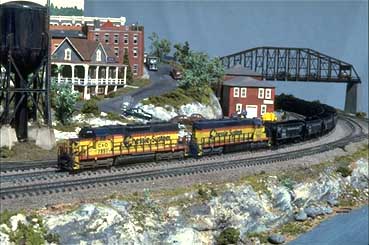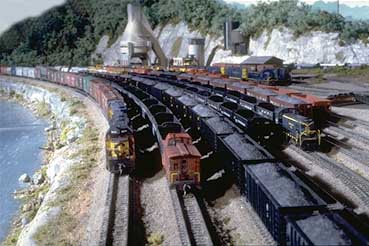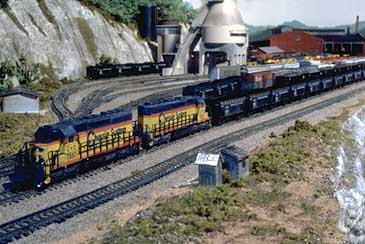|
|
|
John Plant's Hinton & Art Frankforter's CW Cabin Modulesby Bernard Kempinski updated 21 may 1999 |
|
The following is an excerpt from an article published in April 1997 Rail Model Journal on John Plant's Hinton and Art Frankforter's CW Cabin modules. Research John made a trip to Hinton and the surrounding area to take photos and obtain research material for the module. William Simonton, a noted Hinton expert, provided further details and drawings while Dorothy Jean Bowling at the Hinton Railroad Museum also provided useful information. A stop at the C&O Historical Society in Clifton Forge, VA was also invaluable for historic photos and details about the area. |
|
Design
|
 |
| With it's long and narrow configuration set hard between a mountain ridge and river, Hinton is an ideal prototype yard to model. The Hinton division point actually consisted of two yards. CW Cabin controlled the west end of the yard and the engine terminal area. To the east of the passenger station, around the curve was an additional yard at Avis, where freight was classified and cars repaired. To keep the module a reasonable size John combined the classification tracks into the yard in front of the engine terminal. He included 5 tracks for classification and 3 tracks for the engine terminal plus the three NTRAK lines. The yard plan closely follows the prototypical arrangement, albeit in a simplified manner with fewer tracks and crossovers. A track running behind the roundhouse can eventually connect to a staging track hidden behind the skyboards. John's design includes the large radius curve as the rails sweep past the passenger station just as seen in the prototype. |
|
Including the engine terminal with its large roundhouse, coal dock and assorted other structures was a key part of the design. To make the modules more transportable in his truck, the large scratchbuilt round-house required its own modular section.
Both modules use 1x4 butt joined framing with 1/4" luan plywood table tops. To make the roadbed John used a product called Vinylbed made from gray vinyl sheets, cut in strips with precise bevels on each side. While more expensive than cork, it is more durable and should not tear out, particularly at the module joints where cork roadbed traditionally tends to fail. John and Art both used Rigid Wrap plaster impregnated gauze over sculpted layers of one and two inch blue Styrofoam to build up the hills. The plaster gauze provides a solid base for the hand carved rocks. The trees are made individually from dried and dyed weeds. John's wife, Jackie, is an expert in dried floral arrangements and she contributed mightily here. She also painted the backdrop and helped weather rolling stock. John made the streets with painted Scalecrete. The water surface is Envirotex two part resin. Structures
In 1996 John Plant received the ConCor N Scale Award at the N Scale East Convention in Alexandria for his Hinton module set - the best module in the biggest layout ever! John in his typical modest way was the first to point out that several others contributed to his achievement through numerous phone calls, faxes, and letters. Yet John's craftsmanship, modelling talent, and perseverance were the keys to this impressive module set. The continuing good news is that John is building another module and has his sights set on Sewell, WV. |

